Opiates and opioids are classified as analgesic drugs and are obtained from the opium poppy. Heroin is also obtained from the poppy and is a dangerous and popular street drug. Opioids are very useful for the management of acute pain. Physicians frequently prescribe this drug for patients recovering from dental procedures, surgery or those suffering from trauma or injury. Several different types of prescription opioids are effective for blocking pain signals from the brain to the body.
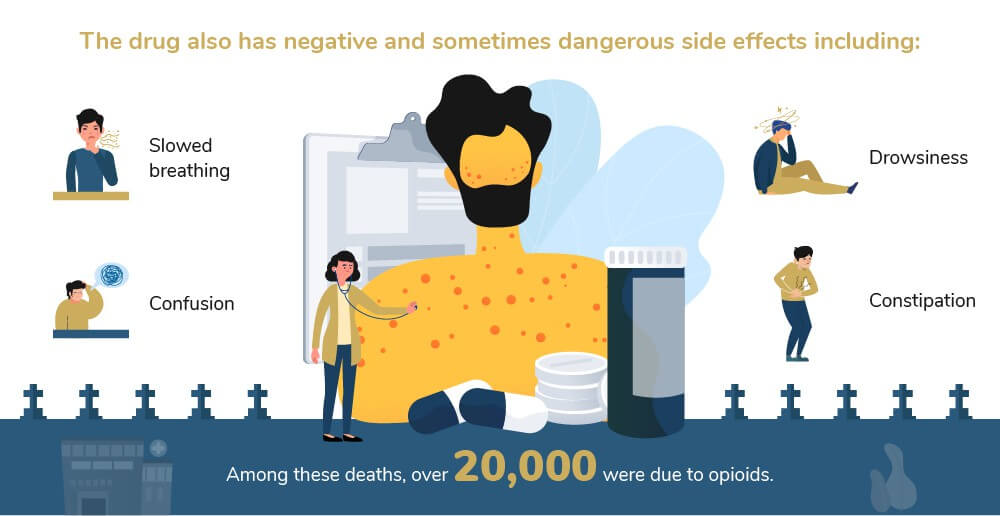
In most cases, opioids are prescribed for the treatment of moderate to severe pain. Besides controlling pain, opioids make certain people feel happy, relaxed or high. This feeling can lead to an addiction and attempting to quit on one’s own can lead to opioid withdrawal. The drug also has negative and sometimes dangerous side effects including:
Opioids are one of the most highly addictive prescription medications currently available. In 2017, the opioid addiction crisis was declared an emergency by the HHS or Department of Health and Human Services. The process for opioid withdrawal can have numerous complications in addition to being extremely painful. The crisis is even worse due to the number of prescriptions written for patients suffering from chronic and legitimate pain to help with pain management in spite of the dangers.
Unfortunately, chronic pain is misunderstood due to a lack of research regarding the available pharmacological methods for treatment. This has resulted in a lot of unanswered questions from patients and doctors alike. If you have been prescribed a short-term prescription for opioids due to a specific condition or pain, you may have already become addicted to the drug. Once you were no longer able to get enough opioids from your doctor to satisfy your addiction, you may have started doctor shopping.
Doctor shopping is when you make appointments with numerous doctors to obtain opioid prescriptions without the knowledge of the physicians. If you mix opioids with alcohol or other drugs or take too large a dosage, you can overdose easily. Opioids lower your blood pressure and suppress your respiratory rate. This can result in coma, seizures and death. In the United States, there are more than 64,000 deaths from drug overdoses.
Among these deaths, over 20,000 were due to opioids. This accounts for more deaths by overdose than any other illegal or legal drug. Once you become addicted to the drug and are unable to get more, your risk of using heroin increases because it is easy to purchase on the street and cheaper. If you use heroin, your risk of both addiction and overdose are extremely high. There are more than 15,000 heroin overdoses in the United States every year.
When used properly, opioids offer relief by masking pain and providing the person with a euphoric feeling. The issue is in the chemical structure of opioids and the interactions with the body and brain. Tolerance with this drug happens quickly. You can become addicted to opioids after your first dosage wears off. Many people begin taking a larger dose than prescribed or taking their doses too close together. Until you stop using the drug, your tolerance will continuously increase.
If you are mixing opioids with alcohol or other drugs to get the effect you want, it is very dangerous. If you have a predisposition for addiction and your pain is unable to be treated in any other way, you may steal opioid prescriptions from your family or friends or start doctor shopping. If you continue with these actions, your supply of prescription opioids will eventually run out. You may then begin to use heroin to satisfy your addiction.
If you have a loved one struggling with opioid addiction, you need to be aware of the signs of untreated addiction. This includes:
Sometimes, opioids are often called narcotics. Even though they will relieve your pain, this drug is different than the painkillers you purchase locally over-the-counter including Tylenol and aspirin. Yes, opioid abuse has become widespread, but help is available. Rehab and detox centers are available throughout the country to help you stop using opioids and live a sober and healthy life. Understanding the effective and safe methods used during your detox and rehab is important and will be discussed in this article.
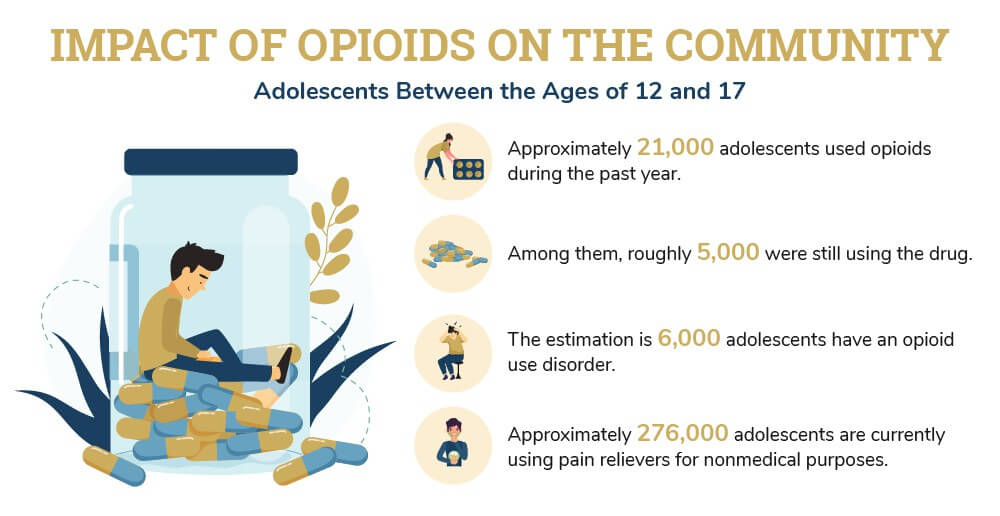
The street names for heroin include smack. junk, dope and black tar. The drug is not used for medical purposes but is available on the street. Heroin is snorted, smoked or injected. Sometimes, the substance is contaminated with other potent drugs including carfentanil and fentanyl. This increases the risk of death and accidental overdose.
Both of these drugs are strong pain medications available by prescription only. In some cases, these drugs are used in combination pills and medications including Tylenol.
The types of hydrocodone include Norco, Lorcet, Vicoprofen, Vicodin and Lortab.
The street names for Fentanyl include China white, Duragesic, subsys and Sublimaze. This is a very potent and frequently abused prescription pain medication. A fatal overdose can result from a tiny amount of the drug.
Codeine is frequently used for combination medications including Robitussin AC and Tylenol #3.
The types of Oxycodone include OxyContin, Percocet, Roxicet, Oxy, Percodan and Endocet.
Methadone is a long-acting opioid available by prescription. This drug is sometimes used to treat opioid addiction.
All of the above drugs are dangerous and can be deadly. If you have become addicted to any of these drugs, treatment is available.
The symptoms of withdrawal manifest within a few hours after your last dose. The length of time you will be in withdrawal is determined by your weight, metabolic rate, when you became addicted to opioids and any medical issues. Your withdrawal symptoms will most likely peak within 72 hours, and subside in approximately seven days. If you have underlying mental health issues or have been abusing opioids for a long period of time, there is a potential for an anxiety disorder or depressive episode once you quit.
Once you initially stop using opioids, you will experience intense cravings for the drug. Replacement drugs including methadone are often necessary when you are in recovery to ensure you remain sober. Once you have completed both detox and rehab, receiving ongoing support and help is critical.
Call us today to get started on your path to recovery. Do not let your opioid addiction control your life. Call right now.
While you are in withdrawal, you will experience unpleasant physical symptoms. The physical symptoms occurring during the first 24 hours include:
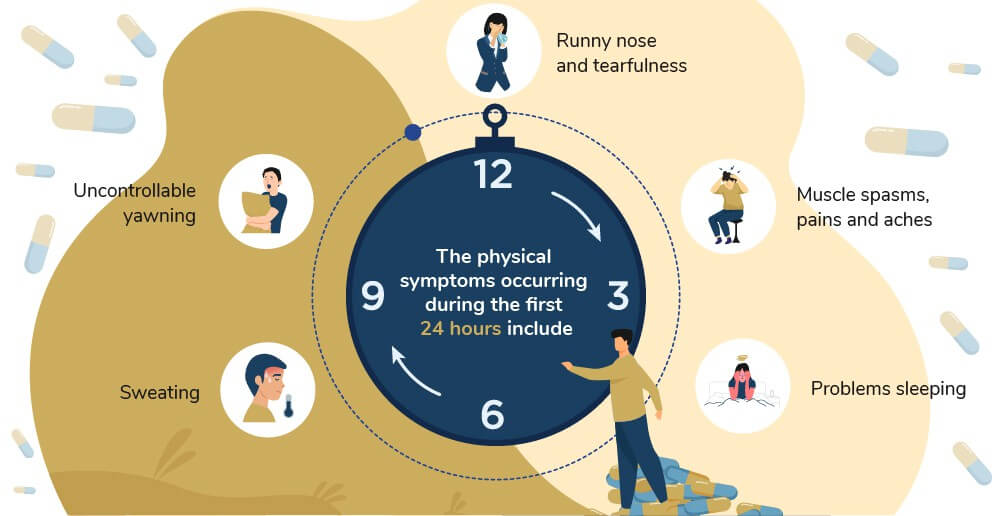
When you are in the peak withdrawal phase, experiencing the following physical symptoms is common.
Your symptoms can persist for as long as a week before they subside. If you do not receive professional medical help, your symptoms can last even longer.
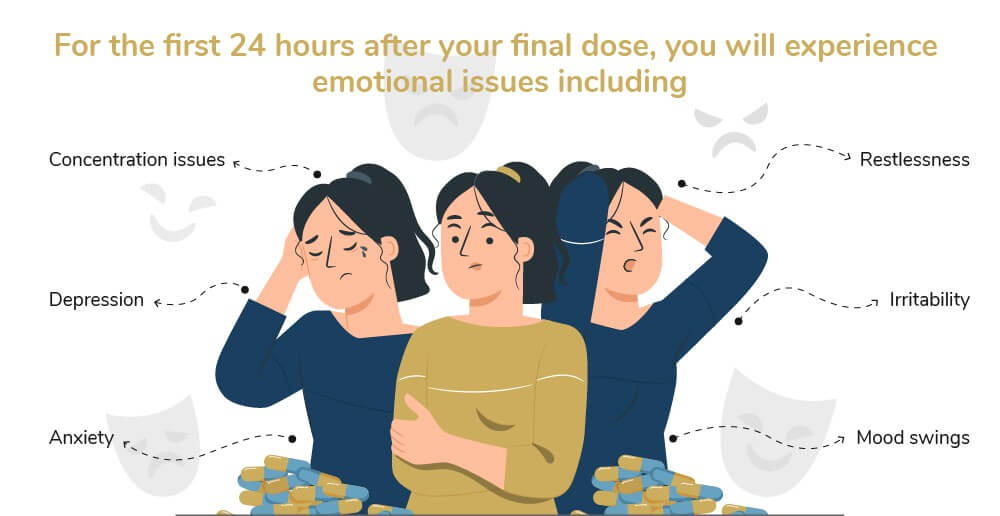
For the first 24 hours after your final dose, you will experience opioid withdrawal and emotional issues including:
During your peak phase, you will become aggressive and paranoid. Your depression may become worse before becoming hyperactive. Trained rehab professionals are necessary to handle this state.
You can, but this method is not effective, more painful and your withdrawal symptoms will last longer. You may have the determination necessary to beat your addiction, but once you experience the withdrawal symptoms, quitting without assistance is nearly impossible. The withdrawal symptoms are both distressing and extremely painful. When you stop using opioids, there is a risk of anxiety and depression. Stopping cold-turkey means you are not supervised and the risk of relapse dramatically increases.
When you are in withdrawal, you will do nearly anything to decrease the discomfort and pain. The majority of people facing addiction have underlying issues that resulted in drug use and addiction. Even if you somehow manage to successfully quit without help, the moment you are placed in a stressful situation or the circumstances of your life change, the risk of using opioids again is high.
To make certain you have the coping mechanisms to handle whatever happens in your life you need help from counselors. Nearly half of all individuals in rehab are suffering from a mental health issue that has never been treated. A lot of them self-medicate. If an underlying issue is not recognized by a professional, the chance of relapsing is high.
You can safely use short-term aids for sleeping, SSRIs, SNRIs and anti-anxiety medications while in detox. Replacement drugs for opioids including methadone are often used for treatment in medical detox facilities. This type of drug is very useful for the treatment of heroin and opioid addiction. Replacement drugs will decrease the severity of your withdrawal symptoms and successfully block any high if you do relapse.
Quitting opioids cold-turkey is not safe and can be extremely dangerous. Attempting to self-medicate by using either alcohol or other drugs to mask your symptoms of withdrawal is not safe. Trying to detox from opioids at home is incredibly risky when you are trying to quit. This is because part of the process of your withdrawal will include anxiety, paranoia, mood swings and depression.
There is a potential to harm yourself or hurt someone else during your time in recovery. A detox facility provides you with trained medical staff. The supervision you receive decreases the dangers of causing any harm.
While you are in medical detox, an assessment is performed by trained staff for any underlying medical conditions. The physicians can then determine which drugs you can safely take while you are in detox. Once you have taken your last opioid dose, you will be monitored for both emotional and physical symptoms. Since you will experience withdrawal symptoms for about a week after you quit, you will receive medications from doctors to alleviate your symptoms.
The detox staff includes therapists to ensure you receive help with mood swings and emotional issues. When required, doctors will prescribe mood stabilizers. Medical detox is about being surrounded by trained and supportive medical professionals, social workers and counselors to ensure you have everything you need. Once you have completed detox, you move on to recovery and inpatient rehab. You will be working with physicians and doctors to create an ongoing maintenance plan.
You will set achievable and realistic goals for a sober life. Once you have a support plan firmly in place, the chance of a relapse is significantly lower. Depending on your insurance plan, your time in detox and rehab may be covered. As a new patient, you have access to licensed professionals to help you with coverage and insurance issues. If you qualify, the majority of rehab facilities offer to finance.
If you are low-income, government resources are available. Contact Asana Recovery today to learn more about your options. Getting help is critical because opioids kill.
Opioid withdrawal can be dangerous and extremely painful. Contact Asana Recovery today to create a new life.
At Asana Recovery, we understand the devastating impact of opioid abuse and withdrawal. Our dedicated team provides compassionate, personalized care through a range of programs designed to help you recover safely and effectively. No matter where you are in your recovery, we have the right program to support you:
Contact us today to start your recovery from opioid abuse. We’re here to support you every step of the way.
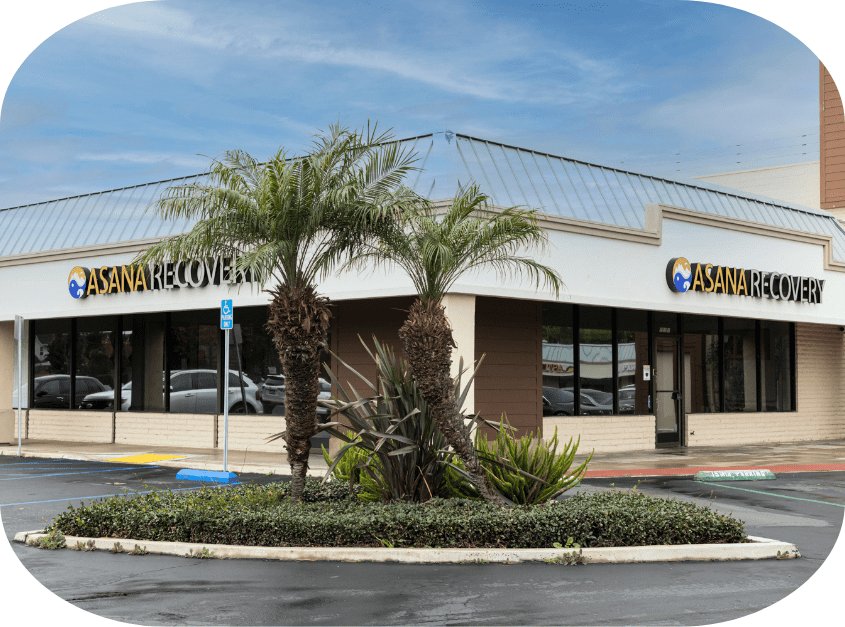
© Copyright 2024 Asana Recovery™ | All Rights Reserved | Privacy Policy
Asana Recovery
We firmly believe that the internet should be available and accessible to anyone, and are committed to providing a website that is accessible to the widest possible audience, regardless of circumstance and ability.
To fulfill this, we aim to adhere as strictly as possible to the World Wide Web Consortium’s (W3C) Web Content Accessibility Guidelines 2.1 (WCAG 2.1) at the AA level. These guidelines explain how to make web content accessible to people with a wide array of disabilities. Complying with those guidelines helps us ensure that the website is accessible to all people: blind people, people with motor impairments, visual impairment, cognitive disabilities, and more.
This website utilizes various technologies that are meant to make it as accessible as possible at all times. We utilize an accessibility interface that allows persons with specific disabilities to adjust the website’s UI (user interface) and design it to their personal needs.
Additionally, the website utilizes an AI-based application that runs in the background and optimizes its accessibility level constantly. This application remediates the website’s HTML, adapts Its functionality and behavior for screen-readers used by the blind users, and for keyboard functions used by individuals with motor impairments.
If you’ve found a malfunction or have ideas for improvement, we’ll be happy to hear from you. You can reach out to the website’s operators by using the following email
Our website implements the ARIA attributes (Accessible Rich Internet Applications) technique, alongside various different behavioral changes, to ensure blind users visiting with screen-readers are able to read, comprehend, and enjoy the website’s functions. As soon as a user with a screen-reader enters your site, they immediately receive a prompt to enter the Screen-Reader Profile so they can browse and operate your site effectively. Here’s how our website covers some of the most important screen-reader requirements, alongside console screenshots of code examples:
Screen-reader optimization: we run a background process that learns the website’s components from top to bottom, to ensure ongoing compliance even when updating the website. In this process, we provide screen-readers with meaningful data using the ARIA set of attributes. For example, we provide accurate form labels; descriptions for actionable icons (social media icons, search icons, cart icons, etc.); validation guidance for form inputs; element roles such as buttons, menus, modal dialogues (popups), and others. Additionally, the background process scans all the website’s images and provides an accurate and meaningful image-object-recognition-based description as an ALT (alternate text) tag for images that are not described. It will also extract texts that are embedded within the image, using an OCR (optical character recognition) technology. To turn on screen-reader adjustments at any time, users need only to press the Alt+1 keyboard combination. Screen-reader users also get automatic announcements to turn the Screen-reader mode on as soon as they enter the website.
These adjustments are compatible with all popular screen readers, including JAWS and NVDA.
Keyboard navigation optimization: The background process also adjusts the website’s HTML, and adds various behaviors using JavaScript code to make the website operable by the keyboard. This includes the ability to navigate the website using the Tab and Shift+Tab keys, operate dropdowns with the arrow keys, close them with Esc, trigger buttons and links using the Enter key, navigate between radio and checkbox elements using the arrow keys, and fill them in with the Spacebar or Enter key.Additionally, keyboard users will find quick-navigation and content-skip menus, available at any time by clicking Alt+1, or as the first elements of the site while navigating with the keyboard. The background process also handles triggered popups by moving the keyboard focus towards them as soon as they appear, and not allow the focus drift outside it.
Users can also use shortcuts such as “M” (menus), “H” (headings), “F” (forms), “B” (buttons), and “G” (graphics) to jump to specific elements.
We aim to support the widest array of browsers and assistive technologies as possible, so our users can choose the best fitting tools for them, with as few limitations as possible. Therefore, we have worked very hard to be able to support all major systems that comprise over 95% of the user market share including Google Chrome, Mozilla Firefox, Apple Safari, Opera and Microsoft Edge, JAWS and NVDA (screen readers).
Despite our very best efforts to allow anybody to adjust the website to their needs. There may still be pages or sections that are not fully accessible, are in the process of becoming accessible, or are lacking an adequate technological solution to make them accessible. Still, we are continually improving our accessibility, adding, updating and improving its options and features, and developing and adopting new technologies. All this is meant to reach the optimal level of accessibility, following technological advancements. For any assistance, please reach out to